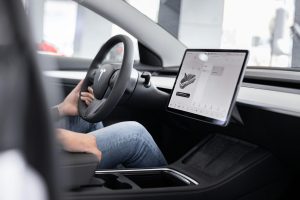Smart Traffic Grids: How Cars Will Talk to Cities by 2026
Picture yourself driving through the bustling city streets in the year 2026. The roads, once clogged with cars, are eerily clear. You seamlessly move through the traffic, your vehicle gliding along at a steady pace. No more frustratingly long lines at the stoplights, no more endless traffic jams, and no more road rage. This may seem like a scene out of a sci-fi movie, but with the advancement of technology, it could soon become a reality. The idea of cars communicating with cities may seem far-fetched, but with the emergence of smart traffic grids, it is set to become the next big thing. In this article, we will explore the concept of smart traffic grids and how they are set to revolutionize the way cars interact with cities by 2026.
The Evolution of Traffic Grids
The concept of traffic grids is not a new one. For decades, cities have relied on traffic signals, stop signs, and road markings to manage the flow of vehicles on their roads. However, with the rise in population and the increase in the number of cars on the road, these traditional methods have proven to be inefficient. This has led to the development of smart traffic grids, which use advanced technology to manage traffic in a more effective and efficient manner.
What are Smart Traffic Grids?
Smart traffic grids refer to a network of intelligent traffic management systems that use real-time data and advanced technology to control the flow of vehicles on the road. These systems are designed to communicate with vehicles, traffic signals, and other elements of the road infrastructure, creating a seamlessly connected system. This enables cities to not only monitor and manage traffic but also gather valuable data for future planning and optimization.
One of the key features of smart traffic grids is the use of Artificial Intelligence (AI). AI algorithms are used to process the real-time data collected from vehicles and other sources, allowing the system to make informed decisions on traffic management. This means that traffic signals can be adjusted in real-time based on the flow of vehicles, reducing congestion and improving overall traffic flow.
How Cars Will Communicate with Cities
So how exactly will cars communicate with cities in a smart traffic grid system? The answer lies in vehicle-to-infrastructure (V2I) communication. V2I technology allows vehicles to share data with traffic signals and other elements of the road infrastructure. This data exchange enables the traffic grid system to make real-time adjustments, such as changing traffic signal timings or suggesting alternative routes, to improve traffic flow.
In addition to V2I communication, smart traffic grids also utilize vehicle-to-vehicle (V2V) communication. This allows vehicles to communicate with each other, sharing information such as speed, location, and direction. This data is then used to adjust driving patterns and prevent accidents. For example, if one car detects heavy braking, it can communicate this information to other nearby vehicles so they can adjust their speed accordingly, preventing a potential collision.
The Benefits of Smart Traffic Grids
The implementation of smart traffic grids has many benefits for both cities and drivers. One of the main advantages is the reduction of traffic congestion. By optimizing traffic flow, smart traffic grids can reduce travel time and improve the overall driving experience. This is not only beneficial for drivers but also for the environment, as it reduces the emissions produced by idling vehicles.
In addition, smart traffic grids have the potential to prevent accidents and save lives. By allowing vehicles to communicate with each other and the city’s infrastructure, the system can detect potential hazards and take preventive measures, such as changing traffic signals or alerting drivers. This will not only save lives but also reduce the overall number of accidents on the road.
The Future Is Here
Smart traffic grids may seem like a futuristic concept, but it is already becoming a reality in many cities around the world. In fact, cities like Singapore, Barcelona, and London have already implemented smart traffic grid systems with promising results. With the advancements in technology, it is predicted that by 2026, most major cities will have fully integrated smart traffic grids.
The future of transportation is undoubtedly exciting, and smart traffic grids are set to play a significant role in shaping it. With better traffic management, improved safety, and reduced environmental impact, smart traffic grids are a win-win solution for both cities and drivers. So, buckle up and get ready to experience a new era of transportation with smart traffic grids by 2026.











